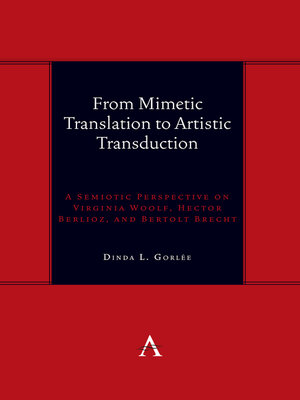From Mimetic Translation to Artistic Transduction
ebook ∣ A Semiotic Perspective on Virginia Woolf, Hector Berlioz, and Bertolt Brecht. · Anthem symploke Studies in Theory
By Dinda Gorlée

Sign up to save your library
With an OverDrive account, you can save your favorite libraries for at-a-glance information about availability. Find out more about OverDrive accounts.
Find this title in Libby, the library reading app by OverDrive.



Search for a digital library with this title
Title found at these libraries:
| Library Name | Distance |
|---|---|
| Loading... |
Roman Jakobson gave a literary translation of the double words and concepts of poetical hyper translation. Language can transmit verbal translation to explore new ways of thinking about music and other arts. Thomas A. Sebeok deconstructed the energy of translation into the duplicated genres of artistic transduction. In semiotics, transduction is a technical expression involving music, theater, and other arts. Jakobson used Saussure's theory to give a single meaning in a different art but with other words and sounds, later followed by Peirce's dynamic energy with a floating sensation of the double meaning of words and concepts. For semiotician Peirce, literary translation becomes the graphical vision of ellipsis, parabole, and hyperbole. Ellipsis is illustrated by Virginia Woolf's novel The Waves to give a political transformation of Wagner's opera Das Rheingold. Parabole is illustrated by the two lines of thought of Hector Berlioz. He neglected his own translation of Virgil's Aeneid, when he retranslated the vocal text to accompany the musical lyrics of his opera The Trojans. Hyperbole is demonstrated by Bertold Brecht's auto-translation of Gay's The Beggar's Opera. In the cabaret theater of The Three penny Opera, Brecht recreated his epic hyper-translation by retranslating the language of the folk speech of the German working classes with the jargon of criminal slang.
|Transduction is beyond translation: both retranslation and auto translation move beyond the transferal of one language to another to signify the speculative attempts to examine and execute the belief, concepts, and meaning of the level of different arts. The art of translating means the analytical exercise of transferring, rotating, and twisting one language into another art, but to retranslate (or auto translate) literary translation, the objective of retranslation or self-translation is to create from translation the poetic and lyrical terms of transduction. In the translation of literary language, the translator can monopolize his situation to break up language to give a different art with or without music or another tool of the critic. The new transduction gives the audience a piece of another linguistic and/or non-linguistic art in a drawing, novel, or opera.
The semiotic scholar of literature Roman Jakobson gave a literary translation of the double words and concepts of poetical hyper translation. Language can transmit verbal translation to explore new ways of inventing and thinking about writing novels, musical theater, and the other arts. Thomas A. Sebeok deconstructed the energy of translation into the duplicated genres of artistic transduction. In semiotics, transduction is a technical expression of language and non-language, involving music, theater, and other arts. Jakobson used Saussure's theory to give a single meaning connecting the thought and sound of words, but later he followed Charles S. Peirce's symbolic logic with a floating sensation of the double meaning of words and concepts to give different symbols to the signs. For Peirce, literary translation becomes the graphical visions of ellipsis, parabole, and hyperbole.
Language and non-language play a role in transforming translation into transduction. Ellipsis is illustrated by Virginia Woolf's novel The Waves to give a political transformation to change Wagner's opera, Das Rheingold. Parabole is illustrated by the two lines of thought of Hector Berlioz. He neglected his own translation of Virgil's Aeneid, when he retranslated the vocal text to accompany the musical lyrics of his opera The Trojans. Hyperbole is demonstrated by Bertold Brecht's auto-translation of Gay's The Beggar's Opera. In the cabaret theater of The...






